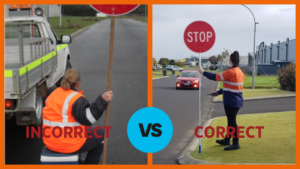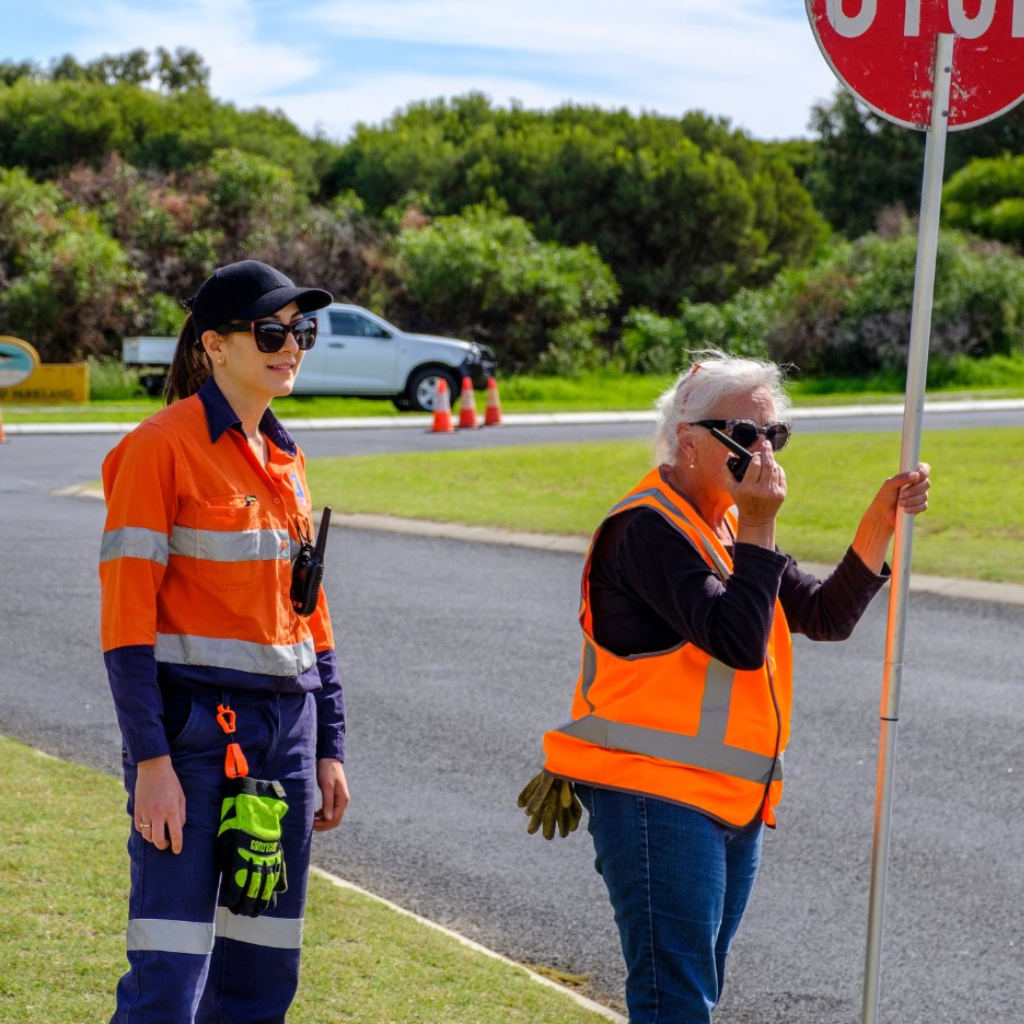Traffic management worksites are important for ensuring safety on the roads during construction or maintenance work. However, there are common non-compliances that can lead to accidents and injuries. Let us assist you in avoiding these non-compliances. We will discuss the top 5 traffic management worksite non-compliances you need to know about and provide tips on how you and your team can avoid.
1. Escape routes not in place and blocked
An escape route is a designated area where workers can safely move away from oncoming traffic in case of an emergency. One of the most common non-compliances is the absence of proper escape routes. Without these routes, workers are left vulnerable to accidents and injuries. To comply with safety regulations, it is important to clearly mark and designate escape routes on the worksite.
Have you ever considered the ramifications of not having a clear escape route at all times?
❌ You may think, it won’t happen to me!
❌ You may think, traffic is slowed to 40km p/h, I’ll have plenty of time to move!
❌ You may think, I’m only turning around for 2 minutes to have a chat to a fellow colleague about weekend plans!
If you work in industry, we encourage you all to talk to your team and raise the importance of an escape route.
✔️ Always be prepared, you want to escape quickly if required
✔️ Use a safety buffer if required
✔️ Don’t allow any machinery to park in, around or near active traffic control area
✔️ Check escape routes regularly, ensure they are accessible at all times and not obstructed such as nearby parked cars, esky or bags etc
✔️ Consider the drivers perspective, including the surrounding areas and possible distractions leading up to the traffic control point
✔️ Position yourself off the roadway with an escape route, but, also in a prominent position where road users will see you in time to safely stop
2. Lack of or incorrect after care signage
After care signage is an essential component of traffic management worksites. These signs provide important information to road users on what to expect after they pass through the worksite. However, it is common to find worksites without these signs, which can lead to confusion and accidents. To comply with safety regulations, it is important to ensure that after-care signage is in place and clearly visible to road users.
Be sure to check this next time you are preparing or implementing your Traffic Management Plan (TMP)
???? ??? ??? ????? ???? ???? ??? ????? ?? ?????
If so, has an after-care Traffic Guidance Scheme (TGS) been provided for when there are no workers on site? Be sure you check these additional items with your next TMP:
✔️ Aftercare details and relevant TGSs must be included in your TMP;
✔️ Tip (don’t forget) – all redundant equipment must be removed from the site or placed in a safe, secure location within the worksite; and
✔️ Records retained showing what TGS/s was implemented and who/when conducted the close down inspection prior to leaving site.
3. Lack of or miscommunication on site
Effective communication on the worksite is crucial to ensure the safety of workers and road users. It is common to find worksites without proper communication channels. This can lead to confusion and miscommunication, which can result in accidents and injuries.
To comply with safety regulations, it is important to establish clear communication channels on the worksite and ensure that all workers are aware of them. Ensure you are having regular communication with contractors on site and always ensure your two-way radios are in working order.
Tips:
- Periodically check you still have contact with team members
- Ensure you are clear and concise with your tone and pace of speech
- Reconsider the use of jargon!
- Use the correct channels
4. Insufficient end of queue protection
Traffic queuing and delays are an expected consequence of any temporary traffic management roadworks site. The following considerations should be made during the design of any TMP.
✔️ Speed of traffic
✔️ Traffic Volume
✔️ Work times and duration
✔️ Worksite length
✔️ Site distance
✔️ Driver reaction times
✔️ Type of traffic using the road
Tips to avoid end of queue collisions:
- Provide Advance Warning: Provide advance warning signs well before the worksite to alert drivers of upcoming roadworks. This can help to reduce the speed of approaching vehicles, allowing drivers to have more time to react to the situation.
- Increase Visibility: Ensure that the worksite is highly visible by using appropriate signage, cones, and other visual aids. This can help to make the worksite stand out to drivers and reduce the chances of accidents occurring.
- Use Queue Warning Systems: Queue warning systems can be used to alert drivers of the presence of a queue ahead. These systems can be used to trigger warning signs, flashing lights, or even audible alerts to drivers approaching the worksite.
- Use Traffic Control Devices: Use traffic control devices such as temporary barriers, cones, and delineators to create a physical barrier between the end of the queue and approaching traffic. This can help to prevent vehicles from accidentally driving into the back of the queue.
- Provide Clear Information: Provide clear and concise information to drivers about what to expect at the worksite, including the length of the queue and any delays they should anticipate. This can help to reduce frustration and impatience among drivers, which can lead to reckless driving.
- Monitor and Adjust Traffic Flow: Continuously monitor traffic flow and adjust traffic management measures as necessary. This can help to ensure that traffic flows smoothly and that queues do not become excessively long, reducing the likelihood of accidents.
5. Poor record keeping & insufficient sign checks
Keeping accurate records of all activities on the worksite is essential to ensure compliance with safety regulations. However, poor record keeping is a common non-compliance in traffic management worksites. This can lead to legal issues and can also make it difficult to identify and rectify safety issues on the worksite. To comply with safety regulations, it is important to maintain accurate and up-to-date records of all activities on the worksite.
Remember, everything must be documented, documented, documented!!
Records must be easily accessible in the future.
If you want to test your record keeping, can you easily (and quickly) locate worksite records from a worksite that was implemented over 12 months ago?
In Western Australia, the requirements for retaining traffic management records are outlined in the Main Roads Western Australia Traffic Management for Works on Roads Code of Practice. Main Roads recommends that traffic management records be securely stored for a period of not less than seven (7) years from the date of completion of the works.
This includes records such as traffic management plans, risk assessments, site plans, and any other documentation related to the planning, implementation, and monitoring of traffic management during road works or events. The purpose of retaining these records is to ensure that there is a record of the traffic management measures taken and that they comply with the relevant standards and regulations.
It’s important to note that in some cases, other legislation or regulations may require longer retention periods for certain types of records. Therefore, it’s always advisable to check the specific requirements for your project and location to ensure compliance with all relevant regulations.
Summary
We covered the top 5 traffic management worksite non-compliances you need to know about, now by being aware of these and taking steps to rectify them, we can ensure that traffic management worksites are safe for all workers and road users.
Be sure to share this article [5 traffic management worksite non-compliances you need to know about] with others you think will benefit from these tips!
Do you need traffic management training?
AusQ Training offer a range of courses to assist you in the traffic management or construction industry, in Bunbury, Perth and all over WA – to view our range of public training courses [click here] or view our calendar here.
Make a time to chat to one of our Customer Support Team members [here] to discuss your traffic management training needs.



